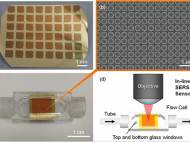First real-time detector for intravenously delivered drugs
 Currently, computerized automated systems deliver drugs intravenously in exact volumes to hospital patients. However, these intravenous (IV) drug delivery systems cannot recognize which medications are in the tubing nor can they determine the concentration of the drug. A group of electrical and computer engineering students at the University of Illinois at Urbana-Champaign (UIUC) have developed a new optical device that can identify the contents of the fluid in an IV line in real-time. Novel drug sensor may help improve the safety of IV drug delivery.
Currently, computerized automated systems deliver drugs intravenously in exact volumes to hospital patients. However, these intravenous (IV) drug delivery systems cannot recognize which medications are in the tubing nor can they determine the concentration of the drug. A group of electrical and computer engineering students at the University of Illinois at Urbana-Champaign (UIUC) have developed a new optical device that can identify the contents of the fluid in an IV line in real-time. Novel drug sensor may help improve the safety of IV drug delivery.
Medication errors are universal problem in health care institutions. One area of potential concern for hospitals is the safety of intravenous (IV) drug delivery systems. Errors associated with these systems include incorrect dosage, unintentional substitution of one drug for another, and co-delivery of incompatible drugs.
“Up to 61 percent of all life-threatening errors during hospitalization are associated with IV drug therapy. So for all the really good things hospitals can do, the data shows that mistakes can occasionally happen”, said Brian T. Cunningham, interim director of the Micro and Nanotechnology Laboratory at UIUC.
The research team uses a technology called Surface-Enhanced Raman Scattering (SERS) – a spectroscopic technique that can deliver chemical and structural information from analyzed molecules in a rapid and nondestructive way. In order to determine the identity of a particular IV drug, they focus laser light onto a nanostructured gold surface that contains millions of tiny “nano-domes” that are separated from each other by as little as 10 nanometers.
The nano-domes are incorporated into the inner surface of IV tubing, where they are exposed to drugs that are dispersed in liquid. The process relies on capturing the light scattered from drug molecules that are in contact with the nano-domes. Researchers use SERS to determine the drug’s molecular signature which they match to known signatures for the drug in order to confirm the presence of a specific medication.
Although nanostructured surfaces for SERS already exist, the nano-dome surface developed by Cunningham group is less expensive because it’s made from a flexible plastic sheet covered with gold domes. Early data showed that this new drug sensor can identify medications including morphine, methadone, phenobarbital, the sedative promethazine and mitoxantrone.
The new sensor can detect drugs in amounts 100 times lower than the commonly used delivered medication concentrations. According to information researchers gave to The Optical Society, it is extremely sensitive and its version at the time can sense a two-drug combination.
The team’s next challenge is further evaluation for combinations of up to ten drugs being delivered at the same time. They developed computer algorithms to automatically interpret the SERS spectra, and they are working to commercialize the new drug sensor.









author
The research team will present its work at The Optical Society’s (OSA) Annual Meeting, Frontiers in Optics (FiO) 2013, being held Oct. 6-10 in Orlando, Florida.